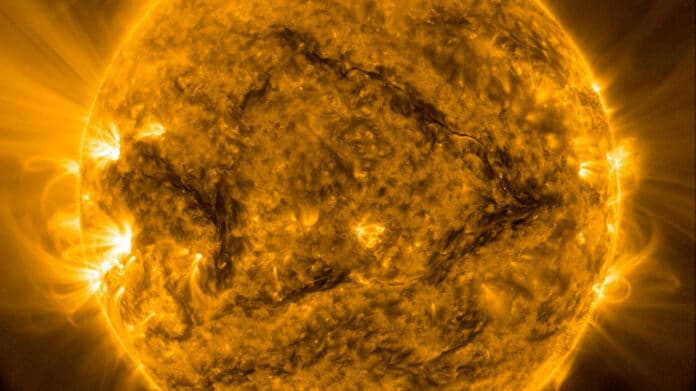Magnetohydrodynamic turbulence regulates energy transfer from large to small scales in many astrophysical systems, including the solar atmosphere. For over half a century, it has been widely accepted that the energy cascade in turbulent plasmas, such as the Sun’s atmosphere, is controlled by MHD wave interactions.
In a new study, scientists at the U.S. Department of Energy’s (DOE) Princeton Plasma Physics Laboratory (PPPL) uncovered a previously hidden heating process that helps explain how the “solar corona” can be vastly hotter than the solar surface that emits it.
By using 200 million hours of computer time for the largest simulation of its kind ever, scientists could reveal the process. Their direct numerical simulation is the first to identify this heating mechanism in 3D space.
Chuanfei Dong, a physicist at PPPL and Princeton University, said, “Current telescope and spacecraft instruments may not have high enough resolution to identify the process occurring at small scales.”
The process known as magnetic reconnection, which violently splits and reunites magnetic fields in plasma—the soup of electrons and atomic nuclei that makes up the solar atmosphere—is the secret ingredient. It was demonstrated by Dong’s modeling of how quickly the magnetic field lines reconnected, converting the large-scale chaotic energy into small-scale internal energy. Due to this efficient conversion of turbulent energy to thermal energy at tiny scales, the corona is effectively heated.
Dong said, “Think of putting cream in coffee. The drops of cream soon become whorls and slender curls. Similarly, magnetic fields form thin sheets of electric current that break up due to magnetic reconnection. This process facilitates the energy cascade from large-scale to small-scale, making the process more efficient in the turbulent solar corona than previously thought.”
“When the reconnection process is slow while the turbulent cascade is fast, reconnection cannot affect the transfer of energy across scales. But when the reconnection rate becomes fast enough to exceed the traditional cascade rate, reconnection can move the cascade toward small scales more efficiently.”
“It does this by breaking and rejoining the magnetic field lines to generate chains of small twisted lines called plasmoids. This changes the understanding of the turbulent energy cascade that has been widely accepted for over half a century. The new finding ties the energy transfer rate to how fast the plasmoids grow, enhancing energy transfer from large to small scales and strongly heating the corona at these scales.”
The most recent discovery shows a regime with a solar corona-like magnetic Reynolds number that is unprecedentedly large. The huge number characterizes the high energy transfer rate of the turbulent cascade. Reconnection-driven energy transfer is more effective the higher the magnetic Reynolds number increases.
The simulation is one of its kind that has taken over 200 million computer CPUs at the NASA Advanced Supercomputing (NAS) facility.
PPPL physicist Amitava Bhattacharjee, a Princeton professor of astrophysical sciences who supervised the research, said, “This numerical experiment has produced undisputed evidence for the first time of a theoretically predicted mechanism for a previously undiscovered range of turbulent energy cascade controlled by the growth of the plasmoids.”
“The impact of this finding in astrophysical systems across various scales can be explored with current and future spacecraft and telescopes. Unpacking the energy transfer process across scales will be crucial to solving key cosmic mysteries.”
Journal Reference:
- Chuanfei Dong et al. Reconnection-driven energy cascade in magnetohydrodynamic turbulence. Science Advances. DOI: 10.1126/sciadv.abn7627
